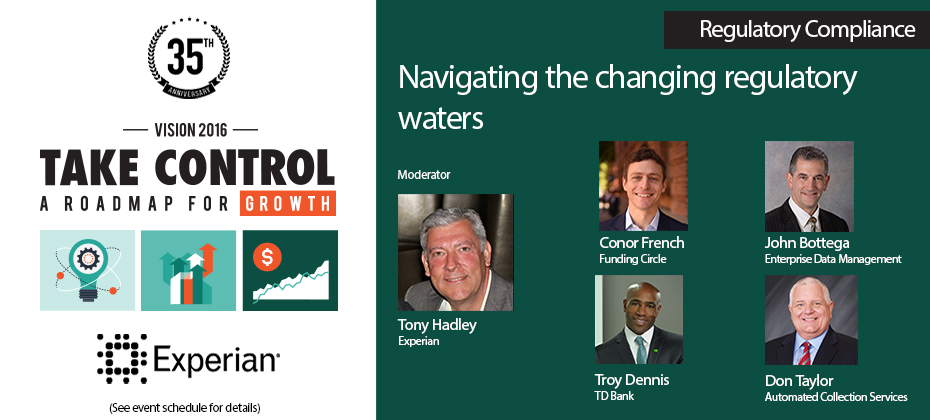Fintech
Fintech

Whether its new regulations and enforcement actions from the Consumer Financial Protection Bureau or emerging legislation in Congress, the public policy environment for consumer and commercial credit is dynamic and increasingly complex. If you are interested to learn more about how to navigate an increasingly choppy regulatory environment, consider joining a breakout session at Experian’s Vision 2016 Conference that I will be moderating. I’ll be joined by several experts and practitioners, including: John Bottega, Enterprise Data Management Conor French, Funding Circle Troy Dennis, TD Bank Don Taylor, President, Automated Collection Services During our session, you’ll learn about some of the most trying regulatory issues confronting the consumer and commercial credit ecosystem. Most importantly, the session will look at how to turn potential challenges into opportunities. This includes learning how to incorporate new alternative data sets into credit scoring models while still ensuring compliance with existing fair lending laws. We’ll also take a deep dive into some of the coming changes to debt collection practices as a result of the CFPB’s highly anticipated rulemaking. Finally, the panel will take a close look at the challenges of online marketplace lenders and some of the mounting regulations facing small business lenders. Learn more about Vision 2016 and how to register for the May conference.

Ensuring the quality of reported consumer credit data is a top priority for regulators, credit bureaus and consumers, and has increasingly become a frequent headline in press outlets when consumers find their data is not accurate. Think of any big financial milestone moment – securing a mortgage loan, auto loan, student loan, obtaining low-interest rate interest credit cards or even getting a job. These important transactions can all be derailed with an unfavorable and inaccurate credit report, causing consumers to hit social media, the press and regulatory entities to vent it out. Add in the laws and increased scrutiny from the Consumer Financial Protection Bureau (CFPB), and Federal Trade Commission (FTC) and it is clear data furnishers are seeking ways to manage their data in more effective ways. At Vision 2016, I am hosting a session, Achievements in data reporting accuracy – maximizing data quality across your organization, with several panel guests willing to share their journeys and learnings attached to the topic of data accuracy. Our diverse panel features leaders from varying industries: Jodi Cook, DriveTime Alissa Hess, USAA Bank Tom Danchik, Citi Julie Moroschan, Experian Each will speak to how they’ve overcome challenges to introduce a data quality program into their respective organizations, as well as best practices around assessing, monitoring and correcting credit reporting issues. One speaker will even touch on the challenging topic of securing funding for a data quality program, considering budgets are most often allocated to strategies, products and marketing directly tied to driving revenue. All lenders are advised to maintain a full 360-degree view of data reporting, from raw data submissions to the consumer credit profile. Better data input equals fewer inaccuracies, and an overarching data integrity program, can deliver a comprehensive view that satisfies regulators, improves the customer experience and provides better insight for internal decision making. To learn more about implementing a data quality plan for your organization, check out Vision 2016.

April is Financial Literacy Month, a special window of time dedicated to educating Americans about money management. But as stats and studies reveal, it might be wise to spend every month shining some attention on financial education, an area so many struggle to understand. Obviously no one wants to talk money day in and day out. It can be complicated, make us feel bad and serve as a source of stress. But as the saying goes, information is power. Over the years, Experian has worked to understand the country’s state of credit. Which states sport higher scores? Which states struggle? How do people pay down their debts? And what are the triggers for when accounts trail into collections? In the consumer space especially, we’ve surveyed individuals about how they feel about their own credit as it pertains to a number of different variables and life stages. Home Buying: 34% of future home buyers say their credit might hurt their ability to purchase a home 45% of future home buyers delayed a purchase to improve their credit to get better interest rates Holiday Shopping: 10% of consumers and 18% of millennials say holiday shopping has negatively affected their credit score Newlywed Life: 60% believe it is important for their future spouse to have a good credit score 39% say their spouse’s credit score or their credit score has been a source of stress in their marriage 35% of newlyweds believe they are “very knowledgeable” regarding credit scores and reports And let’s not forget Millennials: 71% of millennials believe they are knowledgeable when it comes to credit, yet: millennials overestimate their credit score by 29 points 32% do not know their credit score 61% check their credit report less than every 3 months 57% feel like the odds are stacked against them when it comes to finances and 59% feel like they are “going it alone” when it comes to finances The message is clear. Finances are simply a part of life, but can obviously serve as a source of stress. Establishing and growing credit often starts at a young age, and runs through every major life event. Historically, high school is where the bulk of financial literacy programs have targeted their efforts. But even older adults, who have arguably learned something about personal finances by managing their own, could stand a refresher on topics ranging from refinancing to retirement to reverse mortgages. Over the next month, Experian will touch on several timely financial education topics, including highlighting the top credit questions asked, the future of financial education in the social media space, investing in retirement, ways to teach your kids about money, and how to find a legit credit counselor. But Experian explores financial education topics weekly too, committed to providing consistent resources to both businesses and consumers via weekly tweet chats, blog posts and live discussions on periscope. There is always an opportunity to learn more about finances. Throughout the year, different issues pop up, and milestone moments mean we need to brush up on the latest ways to spend and save. It’s nice so many financial institutions make a special point to highlight financial education in April, but hopefully consumers and lenders alike continue to dedicate time to this important topic every month. Managing money is a lifelong task, so tips and insights are always welcome. Right? Check out the wealth of resources and pass it on. For a complete picture of consumer credit trends from Experian's database of over 230 million consumers, purchase the Experian Market Intelligence Brief.

Whether it is an online marketplace lender offering to refinance the student loan debt of a recent college graduate or an online small-business lender providing an entrepreneur with a loan when no one else will, there is no doubt innovation in the online lending sector is changing how Americans gain access to credit. This expanding market segment takes great pride in using “next-generation” underwriting and credit scoring risk models. In particular, many online lenders are incorporating noncredit information such as income, education history (i.e., type of degree and college), professional licenses and consumer-supplied information in an effort to strike the right balance between properly assessing credit risk and serving consumers typically shunned by traditional lenders because of a thin credit history. Regulatory concerns The exponential growth of the online lending sector has caught the attention of regulators — such as the U.S. Treasury Department, the Federal Deposit Insurance Corporation, Congress and the California Business Development Office — who are interested in learning more about how online marketplace lenders are assessing the credit risk of consumers and small businesses. At least one official, Antonio Weiss, a counselor to the Treasury secretary, has publicly raised concerns about the use of so-called nontraditional data in the underwriting process, particularly data gleaned from social media accounts. Weiss said that “just because a credit decision is made by an algorithm, doesn’t mean it is fair,” citing the need for lenders to be aware of compliance with fair lending obligations when integrating nontraditional credit data. Innovative and “tried and true” are not mutually exclusive Some have suggested the only way to assuage regulatory concerns and control risk is by using tried-and-true legacy credit risk models. The fact is, however, online marketplace lenders can — and should — continue to push the envelope on innovative underwriting and business models, so long as these models properly gauge credit risk and ensure compliance with fair lending rules. It’s not a simple either-or scenario. Lenders always must ensure their scoring analytics are based upon predictive and accurate data. That’s why lenders historically have relied on credit history, which is based upon data consumers can dispute using their rights under the Fair Credit Reporting Act. Statistically sound and validated scores protect consumers from discrimination and lenders from disparate impact claims under the Equal Credit Opportunity Act. The Office of the Comptroller of the Currency guidance on model risk management is an example of regulators’ focus on holding responsible the entities they oversee for the validation, testing and accuracy of their models. Marketplace lenders who want to push the limit can look to credit scoring models now being used in the marketplace without negatively impacting credit quality or raising fair lending risk. For example, VantageScore® allows for the scoring of 30 million to 35 million more people who currently are unscoreable under legacy credit score models. The VantageScore® credit score does this by using a broader, deeper set of credit file data and more advanced modeling techniques. This allows the VantageScore® credit score model to capture unique consumer behaviors more accurately. In conclusion, online marketplace lenders should continue innovating with their own “secret sauce” and custom decisioning systems that may include a mix of noncredit factors. But they also can stay ahead of the curve by relying on innovative “tried-and-true” credit score models like the VantageScore® credit score model. These models incorporate the best of both worlds by leaning on innovative scoring analytics that are more inclusive, while providing marketplace lenders with assurances the decisioning is both statistically sound and compliant with fair lending laws. VantageScore® is a registered trademark of VantageScore Solutions, LLC.

It’s hard to remember a world without online lenders. Today, fintech players continue to pop up, making it easier to cross-shop loans and land instant approvals. Gone are the days of lengthy applications and waiting to hear if you’ve scored the latest credit line or personal loan. Consumers, especially with top-tier credit, can easily seek lower monthly payments or consolidate another loan with a cash-out option. Whatever the need, there’s a lender ready to serve. Strike that. There’s actually two or three lenders waiting to serve you. In fact, a recent Experian data pull revealed an increasing share of personal loan balances is actually going to lenders outside of the traditional banks and credit union space (they still own the lion’s share of the business). In 2013 (Q4), these more non-traditional lenders had 15.36 percent of personal loan balances. In Q4 of 2015, that number increased to 27.26 percent. The personal loan business today is just over $222.9 billion in outstanding balances. As the competition heats up, lenders will need to diversify, stand out and provide more value to consumers. Those that engage with new, value-added services, and deliver timely, personalized needs-based messages will capture the greatest share of the market. Here is a sampling of ways to draw consumers in and deliver the value they seek in a financial institution: Be Transparent Lending Club, one of the original peer-to-peer lenders and currently the biggest in terms of dollars funded, continues to grow by providing consumers and investors with transparency, good loan terms and speed. Prosper, on the other hand, recently acquired an app that allows their customers to track spending, budget and monitor their credit. They plan to leverage this technology in the near future and offer it to customers and investors for free. Research reveals Millennials especially are looking to tech and free services to manage their personal finances. A recent Experian survey focused on Millennials and credit revealed 48 percent have used free financial services, like Mint, to manage their finances. Additionally, 57 percent use on average three financial apps. Know Your Customers Payoff uses survey data to segment their customers into roughly 10 financial personalities based on how they use and think about their debt. These personality types are used to tailor marketing messages and customer service conversations about how to improve their financial situation. Their site features a quiz, Discover the Secrets of Your Financial Personality, helping consumers and Payoff understand more about trends attached to spending, saving and managing money. Offer Solutions for Debt Consolidation Even after consumers consolidate debt and pay it off successfully, unforeseen expenses, unexpected life events, evolving spending habits and the increasing cost-of-living expenses mean there will always be a market for debt consolidation solutions. Understanding consolidation credit account behavior is mandatory for lenders looking to stand out and stay ahead of the consolidation needs of consumers. Having visibility to consumers’ interest rates, revolving loan balances and the remaining months on existing loans provides unique ways to segment and engage clients with need-based offers. Consumer-tailored messages during the prospecting, acquisition and account management stages of the relationship sets the stage for repeat business. The research is clear. Individuals are willing to switch brands if they feel a different provider will better meet their needs. Lenders – in both the traditional and fintech spaces – should not expect many chances when it comes to getting it right with consumers. Fail to keep them engaged and you’ll fail to keep them. Period. Learn more about identifying profitable consolidation candidates, check out Experian’s annual Vision Conference in May.

Time to dust off those compliance plans and ensure you are prepared for the new regulations, specifically surrounding the Military Lending Act (MLA). Last July, the Department of Defense (DOD) published a Final Rule to amend its regulation implementing the Military Lending Act, significantly expanding the scope of the existing protections. The new, beefed-up version encompasses new types of creditors and credit products, including credit cards. While the DOD was responsible for implementing the rule, enforcement will be led by the Consumer Financial Protection Bureau (CFPB). The new rule became effective on October 1, 2015, and compliance is required by October 3, 2016. Compliance, however, with the rules for credit cards is delayed until October 3, 2017. While there is no formal guidance yet on what federal regulators will look for in reviewing MLA compliance, there are some insights on the law and what’s coming. Why was MLA enacted? It was created to provide service members and their dependents with specific protections. As initially implemented in 2007, the law: Limited the APR (including fees) for covered products to 36 percent; Required military-specific disclosures, and; Prohibited creditors from requiring a service member to submit to arbitration in the event of a dispute. It initially applied to three narrowly-defined “consumer credit” products: Closed-end payday loans; Closed-end auto title loans; and Closed-end tax refund anticipation loans. What are the latest regulations being applied to the original MLA implemented in 2007? The new rule expands the definition of “consumer credit” covered by the regulation to more closely align with the definition of credit in the Truth in Lending Act and Regulation Z. This means MLA now covers a wide range of credit transactions, but it does not apply to residential mortgages and credit secured by personal property, such as vehicle purchase loans. One of the most significant changes is the addition of fees paid “for a credit-related ancillary product sold in connection with the credit transaction.” Although the MAPR limit is 36 percent, ancillary product fees can add up and — especially for accounts that carry a low balance — can quickly exceed the MAPR limit. The final rule also includes a “safe harbor” from liability for lenders who verify the MLA status of a consumer. Under the new DOD rule, lenders will have to check each credit applicant to confirm that they are not a service member, spouse, or the dependent of a service member, through a nationwide CRA or the DOD’s own database, known as the DMDC. The rule also permits the consumer report to be obtained from a reseller that obtains such a report from a nationwide consumer reporting agency. MLA status for dependents under the age of 18 must be verified directly with the DMDC. Experian will be permitted to gain access to the DMDC data to provide lenders a seamless transaction. In essence, lenders will be able to pull an Experian profile, and MLA status will be flagged. What is happening between now and October 2016, when lenders must be compliant? Experian, along with the other national credit bureaus, have been meeting with the DOD and the DMDC to discuss providing the three national bureaus access to its MLA database. Key parties, such as the Financial Services Roundtable and the American Bankers Association, are also working to ease implementation of the safe harbor check for banks and lenders. The end goal is to enable lenders the ability to instantly verify whether an applicant is covered by MLA by the Oct. 1, 2016 compliance date. --- If you have inquiries about the new Military Lending Act regulations, feel free to email MLA.Support@experian.com or contact your Experian Account Executive directly. Next Article: A check-in on the latest Military Lending Act news

For lenders, credit bureau data is vitally important in making informed risk determinations for consumer and small business loans. And the backbone of this data is credit reporting. With the rise of online marketplace lenders, there is a renewed focus on reporting credit data, particularly in light of the rapid growth of this sector. According to Morgan Stanley research, online marketplace loan volumes in the U.S. have doubled every year since 2010, reaching $12 billion in 2014. It is predicted this growth will nearly double by 2020. As more consumers and small businesses flock to online marketplace lenders, these lenders have a growing responsibility to be good stewards of the credit ecosystem, doing their part to support the value of information available for the entire industry – and for their own benefit. After all, failure to report credit data could have an adverse impact on the financial landscape, affecting consumers, small businesses and online lenders themselves. While there are already several online lenders currently reporting credit data, there is still a significant number of the marketplace that do not. So why specifically should marketplace lenders report? 1. Stay One Step Ahead of Regulators. It’s true data reporting is currently voluntary for marketplace lenders. But the Consumer Financial Protection Bureau’s (CFPB) recent activities reflect a growing focus by regulators to advocate for and protect consumers. Voluntary data reporting reflects the spirit of transparency and aligns with many regulatory priorities. By taking proactive steps and reporting data on their own, online lenders can stay one step ahead of regulators, hopefully alleviating the need for new regulations. 2. Gain a Competitive Advantage in the Long Run. Sure, data reporting is about “doing the right thing” for consumers, but it can be good for business too. Online marketplace lenders can gain distinct advantages by reporting. For example, with access to more accurate consumer information, lenders are able to develop and offer more competitive products tailored to the unique needs of their customers. By expanding their offerings, online lenders can differentiate themselves and thereby grow market share. Reporting also enables lenders to emphasize their commitment to consumers as part of their value proposition, demonstrating how they are helping to grow customer credit. Reporting rewards customers with good payment history, allowing them to take advantage of better loan rates and lower fees available to those with exemplary credit scores. This in turn can lead to higher customer satisfaction, loyalty and return business. With access to more complete and comprehensive consumer credit data, online lenders gain a clearer picture of a consumer’s credit worthiness, enabling them to make more informed, and less risky, lending decisions. Reporting also encourages on-time payments. When customers know that lenders report, they are more likely to pay on-time and less likely to default on their debt. 3. Have You Heard of the “Millennials?” Millennials, and their passion for all things Internet-enabled, are the perfect match for online marketplace lenders. In fact, the latest research from Experian reveals 47 percent of millennials expect to use alternative finance sources in the near future. And 57 percent reported they are willing to use alternative companies and services that innovate to meet their needs. Millennials are clearly more open to nontraditional banking, but at the same time have a greater expectation of transparency, making it all the more important for online marketplace lenders to report credit data. 4. Achieve Data Quality. Complying with Fair Credit Reporting Act (FCRA) data furnishing requirements might seem daunting for marketplace lenders, but there are tools and solutions available to help lenders proactively assess the accuracy of credit data and help identify systemic issues. Marketplace lenders can measure and monitor quality and completeness, dispute metrics, as well as industry and peer-benchmarking data. 5. Qualify More Consumers. With reporting, marketplace lenders can gain access to an invaluable wealth of information that goes well beyond the traditional credit score. Armed with robust analytics, online lenders are in a position to qualify more consumers and small businesses, which creates a significant opportunity to gain long-term customers by improving the overall customer experience. --- Reporting really is a win for marketplace lenders and consumers. In the end, it will contribute to a healthy credit ecosystem and ensure lending decisions are based on the highest quality of information available. For more information about data reporting, including how to start, visit www.experian.com/datareporting. Learn more about data reporting, or about our Online Marketplace Lending track, at Experian's annual Vision Conference in May.

Accuracy matters. It matters in dart throwing, math calculations, and now more than ever, in data reporting. The Consumer Financial Protection Bureau (CFPB) issued a bulletin on Feb. 3 warning banks and credit unions that if they fail to meet accuracy obligations when reporting negative account histories to credit reporting companies, the result could be bureau action. As noted in the Fair Credit Reporting Act (FCRA) section 623, data furnishers have an obligation to ensure the accuracy of the information furnished to a Credit Reporting Agency (CRA). Violation of these rules presents a variety of risks, and the regulatory agencies have enforced harsh consequences. Avoiding penalties is certainly a strong incentive for data furnishers to implement a formal compliance management system and data quality program. But there are additional benefits to ensuring accuracy – most notably keeping customers happy and loyal, and maintaining a reputable brand in the marketplace. Today’s consumers increasingly understand the impact of credit scoring and data reporting, and recognize a poor credit score can impact their lives in major ways. Credit is tied to so many milestone financial moments. Securing mortgage loans, auto loans, obtaining low-interest rate interest credit cards and securing private student loans can all be derailed with an unfavorable and inaccurate credit report. Not to mention credit reports can influence one’s eligibility for rental housing, setting premiums for auto and homeowners insurance in some states, or determining whether to hire an applicant for a job. To properly serve customers who simply expect a fair and accurate representation of their financial history, data furnishers must be able to guarantee the credibility of their reported data. Those organizations that cannot ensure accuracy put their reputation at risk and may lose a customer’s trust and business. “Consumers should not be sidelined out of the basic banking services they need because of the flaws and limitations in a murky system,” Cordray said in the bulletin. “People deserve to have more options for access to lower-risk deposit accounts that can better fit their needs.” The CFPB has handled more than 105,000 credit-reporting complaints in its short history, making credit reporting the third most-complained-about consumer issue. By far the most common types of credit-reporting issues identified by consumers is incorrect information on credit report (77 percent).* Certainly these mistakes are not made intentionally. But speak to a consumer battling an inaccuracy, especially someone in the midst of applying for credit for a specific need, and frustrations can soar quickly. All lenders are advised to maintain a full 360-degree view of data reporting, from raw data submissions to the consumer credit profile. Better data input equals fewer inaccuracies. Additionally, there are comprehensive reporting solutions available to assess the accuracy of consumer credit data. The regulatory environment will without a doubt continue to be a hot topic in the media, fueled by announcements such as these by the CFPB, so lenders should take note and identify processes to ensure complete and utter accuracy. It matters in so many ways, so it’s best to make data reporting a priority now, if it’s not already. Source: CFPB August 2015 Monthly Complaint Report

Who will take the coveted Super Bowl title in 2016? Now that we’re down to the final two teams, the commentary will heighten. Sportscasters, analysts, former athletes, co-workers ... even your local barista has an opinion. Will it be Peyton Manning's Denver Broncos or the rising Carolina Panthers? Millions will make predictions in the coming weeks, but a little research can go a long way in delivering meaningful insights. How have the teams been trending over the season? Are there injuries? Who is favored and what’s the spread? Which quarterback is leading in pass completions, passing yards, touchdowns, etc.? Who has been on this stage before, ready to embrace the spotlight and epic media frenzy? The world of sports is filled with stats resulting from historical data. And when you think about it, the world of credit could be treated similarly. Over the past several years, there has been much hype about “credit invisibles” and the need to “score more.” A traditional pull will likely leave many “no-file” and “thin-file” consumers out, so it’s in a lender’s best interest to leverage alternative scoring models to uncover more. But it’s also important to remember a score is just a snapshot, a mere moment in time. How did a consumer arrive to that particular score pulled on any given day? Has their score been trending up or down? Has an individual been paying off debt at a rapid pace or slipping further behind? Two individuals could have the exact same score, but likely arrived to that place differently. The backstory is good to know – in sports and in the world of credit. Trended data can be attached to balances, credit limits, minimum payment due, actual payment and date of payment. By assessing these areas on a consumer file for 24 months, more insights are delivered and lenders can take note of behavior patterns to assist with risk assessment, marketing and share-of-wallet analysis. For example, looking closer at those consumers with five trades or more, Experian trended data reveals: 27% are revolvers, carrying balances each month 27% are transactors, paying off large portions, or all of their balances 9% are rate surfers, who tend to frequently transfer balances to credit cards with 0% or low introductory rates. Now these consumers can be viewed beyond a score. Suddenly, lenders can look within or outside their portfolio to understand how consumers use credit, what to offer them, and assess overall profitability. In short, trended data provides a more detailed view of a borrower’s historical credit performance, and that richness makes for a more informed decision. Without a doubt, there is power in the score – and being able to score more – but when it comes time to place your bets, the trended data matters, adding a whole new dimension to an individual’s credit score. Place your wagers accordingly. As for who will win Super Bowl 2016? I haven’t a clue. I’m more into the commercials. And I hear Coldplay is on for the half-time show. If you’re betting, best of luck, and do your homework.

With the rapid growth in the number of online marketplace lenders , and projections the field will continue to grow in 2016, winning the race to greater revenue and profitability is key to survival. In 2014, online marketplace lenders issued loans totaling around $12 billion in the United States. In a recent report, Morgan Stanley said it expects the U.S. number to grow to $122 billion by 2020, and the global number will surpass $280 billion in the same time period. Investors fear growth in acquisition costs will erode profitability as more online marketplace lenders enter the market. And as portfolios grow, there will be a need for greater sophistication as it pertains to managing accounts. Online marketplace lenders use a variety of different models to generate revenue including charging interest, loan origination and other service fees. However, regardless of the model, there are typically three key levers all should monitor in order to increase their odds for a profitable and sustainable future. 1. Cost per Account (CPA) CPA is more than a simple calculation spreading marketing cost across new account volume. Rather, it is a methodical evaluation of individual drivers such as channel lead cost, success rates, identity verification and cost of marketing collateral. When measured and evaluated at the granular lever, it is possible to make the most informed strategic decisions possible. Marketplace lenders will have to go much deeper than simply evaluating lead costs, clicks, completed and accepted applications, and funding/activation including whether customers take the loan proceeds or use a revolving product. Don’t forget ID verification and the costs associated with risk mitigation and determining if the low-risk customers are deciding to apply elsewhere. In addition, take into account marketing costs including collateral and channel strategies including any broadcast media, direct mail, web and social media expenses. Evaluate results across various product types – and don’t forget to take into account web content and layout, which can impact all metrics. 2. First Pay Default (FPD) FPD is not a long-term loan performance measure, but it is a strong indicator of lead source and vintage quality. It will most closely correlate to long-term loan performance in short-term loans and non-prime asset classes. It is also a strong indicator of fraud. The high value of online loans, combined with the difficulty of verifying online applicants, is making online lenders a prime target for fraud, so it is essential to closely monitor FPD. Online lenders’ largest single cost category is losses from unpaid loans with fraud serving as a primary driver of that number. It is important to evaluate FPD using many of the same segments as CPA. Online lenders must ask themselves the tough questions. Is a low-cost lead source worthwhile? Did operational enhancements really improve the customer experience and credit quality? 3. Servicing Online account servicing is generally the least costly means of servicing customers, an obvious advantage for online marketplace lenders. However, a variety of factors must be considered when determining the servicing channels to use. These include avoidance of customer backlash and regulatory scrutiny, servicing channel effectiveness in providing feedback regarding product design and administration, servicing policies and marketing collateral. Already, we know the legal and regulatory landscape will evolve as policy makers assess the role of marketplace lending in the financial system, while a recent federal appeals court ruling increases the risk that courts could deem some loans void or unenforceable, or lower the interest rates on them. An effective customer complaint escalation policy and process must also be created and allow for situations when the customer is not “right.” Voice of the customer (VOC) surveys are an effective method of learning from the customer and making all levels of staff know the customer better, leading to more effective marketing and account servicing. Lastly, online lenders can’t ignore social media. They should be prepared for customers, especially millennials, to use it as a means to loudly complain when dissatisfied. But also remember that the same media can be an excellent medium for two-way engagement and result in creating raving fans. A Final Consideration As online marketplace lenders continue to come of age, they are likely to find themselves facing increased competition from incumbent consumer lenders, so optimizing for profitability will be essential. Assessing these three key areas regularly will help in that quest and establish their business for a sustainable future. For more information, visit www.experian.com/marketplacelending.

The world of online marketplace lending has grown tremendously over the past several years. Still, for as much hype as it has received, it’s important to note the sector represents only 1.1 percent of unsecured loans and 2.5 percent of small business loans in the United States. While the industry is still in its infancy, it's expected to grow at an annual rate of 47 percent in the U.S by 2020, according to Morgan Stanley. And as it transitions from its “start-up” phase into “adolescence,” many expect it will become a high-growth, mature and stable market, bringing great benefit to consumers of financial services. So what does the future hold for online marketplace lenders? Who better to weigh in than those in the space, going through the evolution, seeing challenges first-hand and keeping a pulse on where they need to invest in order to survive. This video features a diverse group of leaders in the online marketplace lending industry. // Peter Renton, Founder, Lend Academy Scott Sanborn, COO, Lending Club Sam Hodges, Co-founder, Funding Circle USA Andrew Smith, Partner, Covington & Burling Joseph DePaulo, CEO, College Ave. Kathryn Ebner, VP, Credibly Without stealing all of their thunder, a few key themes emerged for 2016. Online marketplace lenders will look to expand their product offerings into all credit verticals – personal loans, auto, student, small business and beyond. Expect competition to continue to heat up. Large institutional investors will increasingly back and test the space. Some players will partner with large banks. Many will explore scoring with the use of alternative data. Innovations to come in customer service and product expansion. Bottom line, alternative finance doesn’t seem so “alternative” anymore. As such, competition will heat up, and regulators will continue to keep an eye on business practices, processes and what it all means for consumers. To learn more about online marketplace lending, visit https://www.experian.com/business-services/landing/marketplace-lending.html

Last December, American Banker named online marketplace lending its innovation of the year as a result of the “industry’s rapid growth and evolution.” Meanwhile, in 2015, millennials scored headlines in nearly every publication imaginable – industries, politicians and academics all trying to understand and articulate how the now largest-living generation will influence how we work, live and lead. So perhaps it’s no surprise the two hot topics have collided this year. Gen Y is tech-dependent and Internet-enabled. They have increasingly grown to expect the tools and services they use to be available online, including anything and everything in the financial services space. Marketplace lenders are ever-so eager to sweep in and serve. Online and mobile solutions are certainly one thing, but Experian’s latest research reveals this generation is also very receptive to “non-bank” lenders for the ease, speed and accessibility they provide. 47 percent of millennials said they are likely to use alternative finance sources in the near future 57 percent reported they are willing to use alternative companies and services that innovate to meet their needs 13 percent said they’ve already taken out a loan from an alternate or non-bank lender As they come of age, hitting those big milestones – college graduations, marriage, starting families, making home purchases – Gen Y is wading through its financial options. Research and logic suggest millennials will without a doubt have a greater openness toward nontraditional banking, representing a huge market for online marketplace lenders. For the millennial entrepreneurs especially, marketplace lending is proving to be a good fit. “They are on the earlier curve of their small business ownership and entrepreneurial paths,” David Solis, sales performance manager at Bank of America, told CNN Money. “It makes sense they’re going to be pursuing alternative forms of lending.” Affluent millennials are another segment open to alternative financial services. A 2015 LinkedIn study on this specific target stated affluent millennials are particularly likely to envision a cashless, sharing-based economy in the future, where banks no longer serve as their primary financial institutions. Nearly seven out of 10 affluent millennials are likely to consider such offerings outside of the traditional financial services space, compared to just 47 percent of affluent Gen X’ers. The millennial generation may not fully understand all products traditional banks offer, since they rarely set foot in “brick-and-mortar” establishments, but they are a prime market for online investing and lending services. They’re more experimental, more digital, less loyal. In short, they are looking for financial services that are as tech-savvy as they are; those who don’t keep up may get left behind, and online marketplace lenders are certainly positioning themselves to win over this generation. To be most successful in capturing this highly sought-after generation, online marketplace lenders will need to continue to innovate both in terms of differentiating their product offerings and getting more sophisticated in their targeted marketing approach. As the online marketplace continues to expand with more players, heating up with increased competition, segmentation strategies will be key in finding the right borrowers and matching them with the right offer. As we head into 2016, there is no doubt many will continue to monitor the financial services trends emerging. Chances are online marketplace lenders and millennials will likely be attached to many of the headlines. For more information, visit www.experian.com/marketplacelending.

Understanding the Impact of New Marketplace Lending Regulations The online marketplace lending sector has enjoyed unprecedented growth these past few years. According to a recent Morgan Stanley research report, the volume of loans extended by online marketplace lenders in the United States has doubled every year since 2010, hitting $12 billion last year. Some analysts speculate this growth will continue at a compound annual rate of 47 percent through 2020. The market’s growth, coupled with new, disruptive lending models, is now prompting regulators in Washington to raise questions about the potential opportunities and challenges for consumers, small businesses, and the safety and soundness of our financial system. Last July, the Treasury Department issued a request for information to better understand the benefits and risks associated with new online lending platforms and other “fin-tech” startups. The Treasury’s RFI sought information about how these entities’ business models differ from traditional lenders, their impact on financially underserved consumers, and ultimately whether the regulatory framework should evolve to ensure the safe growth of this emerging marketplace. They were also interested in how online lenders were assessing credit risk of borrowers. Most comments the Treasury Department received from online lenders focused on the positive impact that innovation in financial services could have on consumers and small businesses. For example, in an open letter to the Treasury, Lending Club Founder and CEO Renaud Laplanche stated his company’s role in “bringing more transparency, removing friction, reducing systemic risk by requiring a match between assets and liabilities, and offering traditional banks … the opportunity to participate on our platform and benefit from the same cost reductions from which our other borrowers and investors benefit.” Laplanche emphasized the benefits to consumers by noting that “over 70 percent of borrowers on our platform report using their loan to pay off an existing loan or credit card balance and report that the interest rate on their Lending Club loan was an average of seven percentage points lower than they were paying on their outstanding debt or credit cards.” For small businesses, Laplanche explained how commercial loans less than $250,000 tend to be underserved by traditional lenders. “Bank loans from $100k to $250k have fallen 22 percent since 2007, during a period when bank loans of $1 million or greater increased by 56 percent,” he wrote. “Our platform’s automated processes allow us to provide smaller commercial loans that are less available more economically than traditional banks can.” Meanwhile, some commenters called for regulators to increase oversight of the marketplace to provide more certainty. In a joint comment letter, the American Bankers Association and Consumer Bankers Association argued that all lenders — regardless of medium by which they deliver loans — should operate under the same rules and standards. They highlighted the numerous consumer protections in place to protect borrowers — from transparency in pricing, to fair debt collection methods, and data protection — and advocate for these protections to apply in all bank-like activities involving lending or servicing. But what about the Consumer Financial Protection Bureau (CFPB)? The CFPB will take a leadership role to ensure marketplace lenders comply with the fair lending and consumer financial protection laws that the CFPB has authority to enforce. The CFPB has not made any direct notice to the online lending marketplace specifically, but it did issue a notice in October 2014 saying it had no intention of bringing enforcement actions against companies that offer innovative financial products — so long as they benefit consumers. Meanwhile, it is also likely the Federal Trade Commission and state attorneys general will increase their focus on the online lending segment, especially as it relates to how products and services are marketed. The FTC held a symposium on Oct. 30 to examine online lead generation and consumer protection in the lending and education industries. The FTC workshop raised questions about the potential consumer protection challenges of this advertising medium used heavily by online lenders. In particular, there were calls for greater transparency in the use of lead generation, including more information on the ways consumer data is collected through lead-gen websites and how it is used and shared. Online marketplace lenders should expect to stay under the regulatory spotlight – because that’s what success often brings. The sector can avoid undue burdens by ensuring compliance with existing laws and adopting and following industry best practices. For more information, visit www.experian.com/marketplacelending.